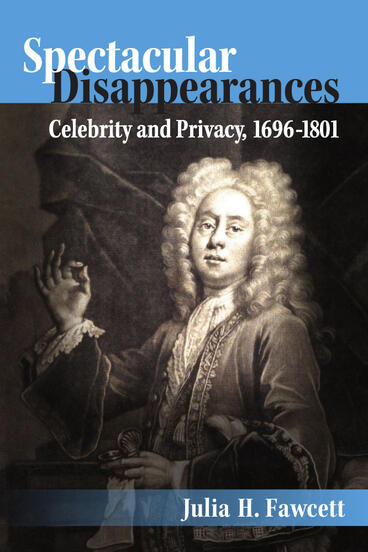Spectacular Disappearances
Celebrity and Privacy, 1696-1801
A look at England’s larger-than-life figures in the 18th century shines a spotlight on contemporary celebrity
Description
How can people in the spotlight control their self-representations when the whole world seems to be watching? The question is familiar, but not new. Julia Fawcett examines the stages, pages, and streets of eighteenth-century London as England's first modern celebrities performed their own strange and spectacular self-representations. They include the enormous wig that actor Colley Cibber donned in his comic role as Lord Foppington--and that later reappeared on the head of Cibber's cross-dressing daughter, Charlotte Charke. They include the black page of Tristram Shandy, a memorial to the parson Yorick (and author Laurence Sterne), a page so full of ink that it cannot be read. And they include the puffs and prologues that David Garrick used to heighten his publicity while protecting his privacy; the epistolary autobiography, modeled on the sentimental novel, of Garrick's protégée George Anne Bellamy; and the elliptical poems and portraits of the poet, actress, and royal courtesan Mary Robinson, a.k.a. Perdita.
Linking all of these representations is a quality that Fawcett terms "over-expression," the unique quality that allows celebrities to meet their spectators' demands for disclosure without giving themselves away. Like a spotlight so brilliant it is blinding, these exaggerated but illegible self-representations suggest a new way of understanding some of the key aspects of celebrity culture, both in the eighteenth century and today. They also challenge divides between theatrical character and novelistic character in eighteenth-century studies, or between performance studies and literary studies today. The book provides an indispensable history for scholars and students in celebrity studies, performance studies, and autobiography—and for anyone curious about the origins of the eighteenth-century self.
Julia Fawcett is Assistant Professor of Theater, Dance, and Performance Studies at the University of California, Berkeley
Reviews
“Well-written and packed with interesting information about a coterie of performer/writers whom we don’t typically read as a coterie. Fawcett’s scholarship makes an important contribution to our understanding of the ways in which some of the first public celebrities coped with their fame.”
—Judith Pascoe, University of Iowa
“This powerfully argued and beautifully written study adds rich historical perspective to celebrity studies.”
—Misty Anderson, University of Tennessee
Finalist, George Freedley Memorial Award, Theatre Library Association
- George Freedley Memorial Award, Theatre Library Association
"Paradoxes, in the hands of unskilled practitioners, often seem to breed more paradoxes, but Fawcett brings a decided clarity to her complex subject. Taken up herself with metaphors of interior and exterior, light and dark, Fawcett encourages her own readers not to dig in so much as to stand back and watch."
- Emily Hodgson Anderson
--Theatre Survey
"Fawcett's concept of overexpression is both insightful and deserving of further exploration."
- Leslie Ritchie
--The Drama Review
"Fawcett astutely observes and analyzes the means by which famous performers managed to present themselves as public property for consumption by audiences and readers who were eager and willing to pay for the privilege of experiencing celebrity self-presentation."
--Eighteenth-Century Fiction- Brian Cowan
News, Reviews, Interviews
Listen: Julia Fawcett interviewed on the New Books Network Link | 10/11/2017

